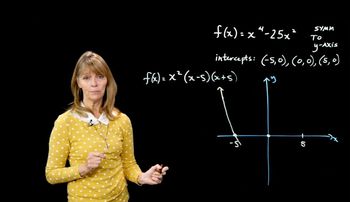Table of contents
- 0. Review of Algebra4h 16m
- 1. Equations & Inequalities3h 18m
- 2. Graphs of Equations43m
- 3. Functions2h 17m
- 4. Polynomial Functions1h 44m
- 5. Rational Functions1h 23m
- 6. Exponential & Logarithmic Functions2h 28m
- 7. Systems of Equations & Matrices4h 6m
- 8. Conic Sections2h 23m
- 9. Sequences, Series, & Induction1h 19m
- 10. Combinatorics & Probability1h 45m
4. Polynomial Functions
Dividing Polynomials
Problem 5
Textbook Question
In Exercises 1–16, divide using long division. State the quotient, and the remainder, r(x). (6x^3+7x^2+12x−5)÷(3x−1)
 Verified step by step guidance
Verified step by step guidance1
Identify the dividend as \(6x^3 + 7x^2 + 12x - 5\) and the divisor as \(3x - 1\).
Set up the long division by writing \(6x^3 + 7x^2 + 12x - 5\) under the division symbol and \(3x - 1\) outside.
Divide the first term of the dividend \(6x^3\) by the first term of the divisor \(3x\) to get the first term of the quotient, which is \(2x^2\).
Multiply \(2x^2\) by the entire divisor \(3x - 1\) and subtract the result from the current dividend to find the new dividend.
Repeat the process with the new dividend: divide the first term of the new dividend by the first term of the divisor, multiply, and subtract, until the degree of the remainder is less than the degree of the divisor.
Recommended similar problem, with video answer:
 Verified Solution
Verified SolutionThis video solution was recommended by our tutors as helpful for the problem above
Video duration:
4mPlay a video:
Was this helpful?
Key Concepts
Here are the essential concepts you must grasp in order to answer the question correctly.
Polynomial Long Division
Polynomial long division is a method used to divide a polynomial by another polynomial of lower degree. It involves a process similar to numerical long division, where the leading term of the dividend is divided by the leading term of the divisor to find the first term of the quotient. This process is repeated, subtracting the resulting polynomial from the original until the degree of the remainder is less than that of the divisor.
Recommended video:
Guided course

Introduction to Polynomials
Quotient and Remainder
In polynomial division, the quotient is the result of the division, representing how many times the divisor can fit into the dividend. The remainder is what is left over after the division process, which cannot be divided by the divisor without resulting in a fraction. The relationship can be expressed as: Dividend = Divisor × Quotient + Remainder.
Recommended video:

Product, Quotient, and Power Rules of Logs
Degree of a Polynomial
The degree of a polynomial is the highest power of the variable in the polynomial expression. It plays a crucial role in polynomial division, as the division process continues until the degree of the remainder is less than the degree of the divisor. Understanding the degree helps in determining the number of times the divisor can be subtracted from the dividend during the division process.
Recommended video:
Guided course

Standard Form of Polynomials
Related Videos
Related Practice

